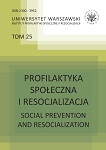Zobowiązanie do określonego postępowania w strukturze sądowych środków wychowawczych stosowanych wobec nieletnich. Analiza pedagogiczna.
Commitment to a Specific Conduct in Court Educational Measures for Minors; a Pedagogical Analysis.
Author(s): Magdalena Staniaszek, Renata Szczepanik, Agnieszka JarosSubject(s): Social Sciences
Published by: Instytut Profilaktyki Społecznej i Resocjalizacji UW
Keywords: juvenile; court educational measures targeting minors; socially useful work; commitment of a minor to a specific conduct; restorative justice; demoralization of minors; juvenile offenders; juvenile delinquency; mediation
Summary/Abstract: The Polish model of juvenile demoralization and delinquency is oriented, first of all, towards educational goals, with the well-being (and welfare protection) of the child as an overarching reason for any legal and social response. The legislator provides judges with a wide range of options, the margin of operation and the possibility to modify means which are set forth in the Act on handling minor-related cases and which are a formal and legal form of response to manifestations of child demoralization, yet imbued with some pedagogical premises. The aim of the paper is to analyze, in pedagogical perspective, one of the educational measures included in the Act, and labelled “commitment to a specific conduct”, and to discuss the place, the nature and, most of all, the potential of this measure. Based on the analysis of research results, we were able to draw our basic conclusion: contents and nature of commitments decided by court do not make use of the full potential of the said educational measure, while the scope and mode of its application only slightly go beyond the paternalistic approach to minors. In practice, the commitment to a specific conduct does not play its compensatory function, and what’s more, has no intended educational impact (in a psycho-pedagogical sense of the term).
Journal: Profilaktyka Społeczna i Resocjalizacja
- Issue Year: 2015
- Issue No: 25
- Page Range: 79-109
- Page Count: 31

